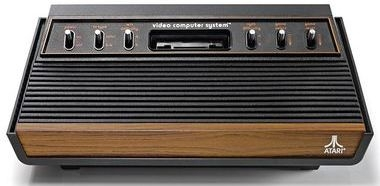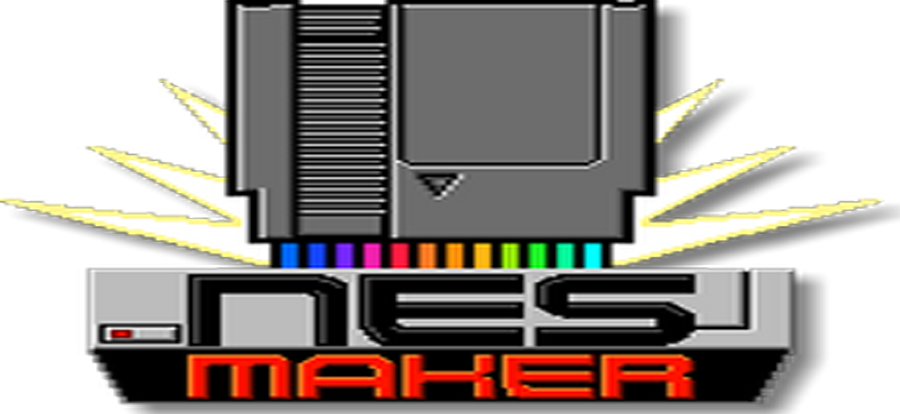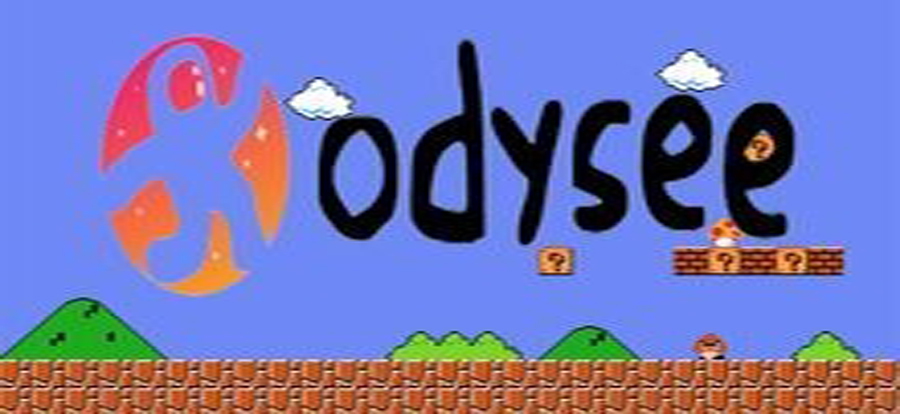

The Atari 2600 (or Atari Video Computer System before November 1982) is a home video game console by Atari, Inc. Released on September 11, 1977, it is credited with popularizing the use of microprocessor-based hardware and ROM cartridges containing game code, a format first used with the Fairchild Channel F video game console in 1976. This format contrasts with the older model of having non-microprocessor dedicated hardware, which could only play the games that were physically built into the unit.
For five years, 1977 until late 1982, the system was officially sold as the Atari VCS, an abbreviation for Video Computer System. Following the release of the Atari 5200 in November 1982, the VCS was renamed to the "Atari 2600", after the unit's Atari part number, CX2600. The 2600 was typically bundled with two joystick controllers, a conjoined pair of paddle controllers, and a game cartridge: initially Combat, and later Pac-Man.
History
Ted Dabney and Nolan Bushnell developed the Atari gaming system in the 1970s. Originally operating under the name "Syzygy", Bushnell and Dabney changed the name of their company to "Atari" in 1972. In 1973, Atari Inc. had purchased an engineering think tank called Cyan Engineering to research next-generation video game systems, and had been working on a prototype known as "Stella" (named after one of the engineers' bicycles) for some time. Unlike prior generations of machines that use custom logic to play a small number of games, its core is a complete CPU, the famous MOS Technology 6502 in a cost-reduced version known as the 6507. It was combined with a RAM-and-I/O chip, the MOS Technology 6532, and a display and sound chip known as the Television Interface Adaptor (TIA). The first two versions of the machine contained a fourth chip in the video circuitry, a standard CMOS 4050 buffer IC. Some later versions of the console eliminated the buffer chip.
Programs for small computers of the time were generally stored on cassette tapes, floppy disks, or paper tape. By the early 1970s, Hewlett-Packard manufactured desktop computers costing thousands of dollars, such as the HP 9830, which packaged Read Only Memory (ROM) into removable cartridges to add special programming features, and these were being considered for use in games. At first, the design was not going to be cartridge-based, but after seeing a "fake" cartridge system on another machine, they realized they could place the games on cartridges essentially for the price of the connector and packaging.
In 1976, Fairchild Semiconductor released their own CPU-based system, the Video Entertainment System. Stella was still not ready for production, but it was clear that it needed to be before there were a number of "me too" products filling up the market, which had happened after they released Pong. Atari Inc. didn't have the cash flow to complete the system quickly, given that sales of their Pong systems were cooling. Nolan Bushnell eventually turned to Warner Communications, and sold the company to them in 1976 for US$28 million on the promise that Stella would be produced as soon as possible.
Key to the eventual success of the machine was the hiring of Jay Miner, a chip designer who managed to squeeze an entire wire wrap of equipment making up the TIA into a single chip. Once that was completed and debugged, the system was ready for shipping.
Launch and success
The unit was originally priced at US$199 ($786 adjusted for inflation), and shipped with two joysticks and a Combat cartridge (eight additional games were available at launch and sold separately). In a move to compete directly with the Channel F, Atari Inc. named the machine the Video Computer System (or VCS for short), as the Channel F was at that point known as the VES, for Video Entertainment System. The VCS was also rebadged as the Sears Video Arcade and sold through Sears, Roebuck and Company stores. Another breakthrough for gaming systems was Atari's invention of a computer-controlled opponent, rather than the usual two-player or asymmetric challenges of the past. When Fairchild learned of Atari Inc.'s naming, they quickly changed the name of their system to become the Channel F. However, both systems were now in the midst of a vicious round of price-cutting: Pong clones that had been made obsolete by these newer and more powerful machines were sold off to discounters for ever-lower prices. Soon many of the clone companies were out of business, and both Fairchild and Atari Inc. were selling to a public that was completely burnt out on Pong. In 1977, Atari Inc. sold 250,000 Video Computer Systems.
For the first year of production, the Video Computer System was manufactured in Sunnyvale, California. The consoles manufactured there had thick plastic molding around the sides and bottom. These added weight to the console, and because all six switches were on the front, these consoles were nicknamed "Heavy Sixers". After this first year, production moved to Hong Kong, and the consoles manufactured there had thinner plastic molding. In 1978, only 550,000 units from a production run of 800,000 were sold, requiring further financial support from Warner to cover losses. This led directly to the disagreements that caused Atari Inc. founder Nolan Bushnell to leave the company in 1978. Despite Bushnell's retirement in 1978, Warren Robinett's invention of the first graphical adventure game, Adventure, was developed the same year and changed the fundamentals of gaming as it unlocked a game with a "virtual space bigger than the screen". Once the public realized it was possible to play video games other than Pong, and programmers learned how to push its hardware's capabilities, the VCS gained popularity. By this point, Fairchild had given up, thinking video games were a passing fad, thereby handing the entire quickly growing market to Atari Inc. By 1979, the VCS was the best-selling Christmas gift (and console), due to its exclusive content, and 1 million units were sold that year.
Atari Inc. then licensed the smash arcade hit Space Invaders by Taito, which greatly increased the unit's popularity when it was released in January 1980, doubling sales to over 2 million units. The VCS and its cartridges were the main factor behind Atari Inc. grossing more than $2 billion in 1980. Sales then doubled again for the next two years; by 1982, the console had sold 10 million units, while its best-selling game Pac-Man sold 7 million copies. The console also sold 450,000 units in West Germany by 1984. By 1982 the 2600 console cost Atari about $40 to make and was sold for an average of $125. The company spent $4.50 to $6 to manufacture each cartridge and $1 to $2 for advertising, and sold it for $18.95 wholesale.
In 1980, the VCS was given a minor revision in which the left and right difficulty switches were moved to the back of the console, leaving four switches on the front. Other than this, these four-switch consoles looked nearly identical to the earlier six-switch models. In 1982, another version of the four-switch console was released without woodgrain. They were nicknamed "Darth Vader" consoles due to their all-black appearance. These were also the first consoles to be officially called "Atari 2600", as the Atari 5200 was released the same year. During this period, Atari Inc. expanded the 2600 family with two other compatible consoles. Despite the faux-wood panels and what would now appear to be primitive graphics, the game console became widely popular for the time. Later however, they designed the Atari 2700, a wireless version of the console that was never released because of a design flaw. The company also built a sleeker version of the machine dubbed the Atari 2800 to sell directly to the Japanese market in early 1983, but it suffered from competition with the newly released Nintendo Famicom.
In a survey mentioned by Jeff Rovin it is reported that more stores reported breakdowns of the Atari 2600 system than any other, and that Atari repair centers seemed to have the most trouble with consoles manufactured in 1980. In one case it is stated that a system was repaired five times before static electricity from a carpet was discovered as having caused the problem. The controllers were also a source of breakage because of the way they could be gripped by a player holding it with their fist, allowing players to get carried away and over control, which was less likely with other systems released at the time, such as the Magnavox Odyssey², which has controllers that are nearly half its size.
Sears Tele-Games 2600s
Atari Inc. also continued their OEM relationship with Sears under the latter's Tele-Games brand label, which started in 1975 with the original Pong. Sears released several versions of the 2600 as the Sears Video Arcade series from 1977 to 1983. These include the Rev. A "Heavy Sixer" model in 1977, the "Light Sixer" model in 1978, the Rev. B "4 switch" model in 1980, and the US version of the Atari 2800 branded as the Sears Video Arcade II in 1983.
Sears also released their own versions of Atari Inc.'s games under the Tele-Games brand — often with different titles[21] — which included the Tele-Games branded variations of text and picture labels. Three games were also produced by Atari Inc. for Sears as exclusive releases under the Tele-Games brand: Steeplechase, Stellar Track, and Submarine Commander.
Sears's Tele-Games brand was unrelated to the company Telegames, which also produced cartridges for the Atari 2600 — mostly re-issues of M Network games.
Decline and remodel
During the 1970s, Atari Inc. continued to grow until it had one of the largest R&D divisions in Silicon Valley. However, it spent much of its R&D budget on projects that seemed out of place at a video game (or even home computer) company[citation needed]; many of these projects never saw the light of day. Meanwhile, several attempts to bring out newer consoles failed for one reason or another, although Atari Inc.'s home computer system (the Atari 8-bit family) sold reasonably well, Warner was pleased as it seemed to have no end to the sales of the 2600, and Atari Inc. was responsible for over half of the company's income.
The programmers of many of Atari Inc.'s biggest hits grew disgruntled with the company for not crediting game developers and many left the company and formed their own independent software companies. The most prominent and longest-lasting of these third-party developers was Activision, founded in 1980, whose titles quickly became more popular than those of Atari Inc. itself. Atari Inc. attempted to block third-party development for the 2600 in court but failed,[23][24][25] and soon other publishers, such as Imagic and Coleco, entered the market. Atari Inc. suffered from an image problem when a company named Mystique produced a number of pornographic games for the 2600. The most notorious of these, Custer's Revenge, was protested by women's and Native American groups because it depicted General George Armstrong Custer raping a bound Native American woman. Atari Inc. sued Mystique in court over the release of the game.
Atari Inc. continued to acquire licenses for the 2600, the most prominent of which included Pac-Man and E.T. Public disappointment with these two titles and the market saturation of poor third-party titles are cited as major contributors to the video game crash of 1983. Suddenly, Atari Inc.'s growth meant it was losing massive amounts of money during the crash, at one point about $10,000 a day. This in part led to the Atari video game burial of 1000s of unsold Atari 2600 games in the desert in New Mexico. Warner quickly grew tired of supporting Atari Inc., and started looking for buyers in 1984.
By mid-1984 most software development for the 2600 had stopped except by Atari and Activision, with third-party developers emphasizing ColecoVision games.[30] Although not formally discontinued, the 2600 was de-emphasized for two years after Warner's 1984 sale of Atari Inc.'s Consumer Division to Commodore Business Machines founder Jack Tramiel, who wanted to concentrate on home computers. He ended all development of console games, including a 2600 Garfield game and an Atari 5200 port of Super Pac-Man. Due to a large library and a low price point, the 2600 and the 2600 Jr. continued to sell into the late 1980s and were not discontinued until 1992. The 2600 ended up outdoing all other hardware that Atari released, in attempt to replicate its success.
Atari 2800
The Atari 2800 is the Japanese version of the Atari 2600, released in October 1983. It was the first release of a 2600 designed specifically for the Japanese market, despite companies like Epoch distributing the 2600 in Japan previously. In fact, Atari's name was inspired by the Japanese game 'Go'.
The 2800 never captured a large market in Japan. It was released a short time after Nintendo's Family Computer, which became the dominant console in the Japanese video game market of the time.
Codenamed "Cindy", and designed by Atari engineer Joe Tilly, the Atari 2800 had four controller ports instead of the standard two on the Atari 2600's. The controllers are an all-in one design using a combination of an 8-direction digital joystick and a 270-degree paddle, designed by John Amber.
The 2800's case design departed from the standard 2600 format, using a wedge shape with non-protruding switches.
Around 30 specially branded games were released for the 2800. Their boxes are in Japanese and have a silver/red color scheme similar to the packaging of Atari's 2600 branded games of the time. The ROM cartridges themselves had identical labels as their 2600 branded counterparts.
Sears liked the design of the Atari 2800 so much, they opted to sell a version under their Tele-Games label. It was released in the US in 1983 as the Sears Video Arcade II, and was packaged with 2 controllers and Space Invaders.
The Atari 2800's case style was used as the basis for the Atari 7800's case style by Barney Huang.
Atari 2600 Jr.
In 1986, a new version of the 2600 was released. The newly redesigned version of the 2600, unofficially referred to as the 2600 Jr., features a smaller, cost-reduced form factor with a modernized, Atari 7800-like appearance. The redesigned 2600 was advertised as a budget gaming system (under US$50) that has the ability to run a large collection of classic games.
The Atari 2600 continued to sell in North America and Europe until 1991, and in Asia until the early 1990s. Its final Atari-licensed release is KLAX in 1990. In 2007, the Atari 2600 was inducted into the Toy Hall of Fame, with 40 million units sold in its lifetime, and the youngest toy to be inducted. In Brazil, the console became extremely popular in the mid-1980s. The Atari 2600 was officially retired by Atari Corp. on January 1, 1992, making it, at the time, the longest-lived home video game console (14 years, 4 months) in video game history. It was later surpassed by the Sega Master System, a console that never formally ended production in Brazil.
The Atari 2600 was also, at the time, the best-selling American-made console, selling 30 million units.
The system was promoted on a United Kingdom TV ad in 1989 in the run-up to Christmas, in which it claimed "The fun is back!". The advertising campaign used its price of under £50 as a selling point. The advert was a re-dubbed version of the early original campaign in the United States. Also, the 2600 Jr. was originally to be packaged with a Pro-Line joystick (the same one used on the Atari 7800), but when it was released, it instead included the original CX-40 Joystick. Later European versions of the 2600 Jr. included a joypad, which was also featured with the European 7800.
Hardware
The CPU was the MOS Technology 6507, a stripped-down version of the 6502, running at 1.19 MHz in the 2600. Though their internal silicon wafer was identical, the 6507 was cheaper than the 6502 because its package included fewer memory-address pins—13 instead of 16. Smaller packaging was, and still is, an important factor in overall system cost, and since memory was very expensive at the time, the 6507's small 8 kB of maximum external memory space was not going to be used up anyway.
The designers of the Atari 2600 selected an inexpensive cartridge interface that had one fewer address than the 13 allowed by the 6507, further reducing the already limited addressable memory to 4 kB (2^12 = 4096). This was believed to be sufficient as Combat was itself only 2 kB. Later games get around this limitation with bank switching. The maximum supported cartridge size is 32 kilobytes.
The console has only 128 bytes of RAM for run-time data that includes the call stack and the state of the game world. There is no frame buffer. Instead the video device has two bitmapped sprites, two 1-pixel "missile" sprites, a 1-pixel "ball," and a 40-pixel "playfield" that is drawn by writing a bit pattern for each line into a register just before the television scans that line. As each line is scanned, a game must identify the non-sprite objects that overlaps the next line, assemble the appropriate bit patterns to draw for those objects, and write the pattern into the register. In a telling reveal of its Pong heritage, by default, the right side of the screen is a mirrored duplicate of the left; to control it separately, the software may modify the patterns as the scan line is drawn. After the controller scans the last active line, a more leisurely vertical blanking interval begins, during which the game can process inputs and update the positions & states of objects in the game world. Any mistake in timing produces visual artifacts, a problem that programmers call "racing the beam".
The 2600's video hardware is therefore highly flexible, but also challenging to program. One advantage the 2600 has over more powerful contemporary competitors such as the ColecoVision is that the 2600 has no protection against altering settings in mid-line. For example, although each sprite nominally has only one color, it is possible to color the rows differently by changing the sprite's color as it is drawn. If the two hardware sprites are not enough for a game, a developer may share one sprite among several objects (as with the ghosts in Pac-Man) or draw software sprites, which is only a little more difficult than drawing a fixed playfield. The Pitfall! screenshot below (section: "Games") demonstrates some of these tricks: the player is a multicolor sprite, one sprite is multiplexed for the logs and the scorpion, and the swinging vine is drawn by shifting the position of the "ball" on each scan line. Despite the hardware limitations, many Atari 2600 games have a lot of action on the screen, creating an engaging experience. Furthermore, the Atari 2600 was one of the first consoles to introduce video game cartridges instead of having hardwired games built into it, allowing for the play of multiple different games rather than the usual one built in.
The Atari originally shipped with two types of controllers, a joystick as well as a pair of paddle controllers. Later, new controllers were added to the game system including a driving controller, a trak-ball controller, and finally keypad controllers. Additionally, the 2600 supports several types of input devices as well as third-party peripherals. Because the Atari joystick port and CX40 joystick became industry standards, many peripherals are interchangeable with the MSX and other Japanese systems, the Commodore 64, Commodore 128, Amiga, Sega Master System, and Mega Drive/Genesis, though functionality may be somewhat limited. Also, although Master System and Mega Drive/Genesis controllers work on the Atari 2600, only the "B" button can be used in most games. Another adapter is the Starpath Supercharger, an add-on created by Starpath to expand the game capabilities of the Atari 2600. The Supercharger's interface adds an extra 6 kB to the Atari 2600's 128 bytes of RAM, allowing for larger games with higher-resolution graphics. A cord coming out of the side of the cartridge plugs into the earphone jack of any standard cassette player. Games for the Supercharger are stored on standard audio cassettes.
Third-party accessories include Wico's Command Control joystick.
The console was designed by Fred Thompson, and the controller was designed by Kevin McKinsey.
Graphics
Main article: Television Interface Adapter
Atari established their system design in order to be compatible with the cathode-ray tube television sets in the late 1970s and early 1980s. The Atari 2600 uses different color palettes depending on the television signal format used. With the NTSC format, a 128-color palette is available, while in PAL, only 104 colors are available. Additionally, the SECAM palette consists of only 8 colors.
Games
In 1977, nine games were released on cartridge to accompany the launch of the machine, including Air-Sea Battle, Star Ship and Street Racer. During the console's lifetime, Atari, Inc. and Atari Corp. published many titles: these games included Adventure (often credited as starting the action-adventure game genre),Breakout, and Yars' Revenge. The console's popularity attracted many third-party developers, which led to popular titles such as Activision's Pitfall! and Imagic's Atlantis. However, two Atari published titles, E.T. the Extra-Terrestrial and Pac-Man, are frequently blamed for contributing to the video game crash of 1983.
Legacy
The Atari 2600 was wildly successful and, during much of the 1980s, "Atari" was a synonym for this particular model in mainstream media and, by extension, for video games in general.
The Atari 2600 was inducted into the National Toy Hall of Fame at The Strong in Rochester, New York, in 2007. In 2009, the Atari 2600 was named the second greatest video game console of all time by IGN, who cited its remarkable role as the console behind both the first video game boom and the video game crash of 1983, and called it "the console that our entire industry is built upon".
Atari 2000
The Atari 2000 (model number CX-2000) was a prototype version of the Atari 2600 that was intended to be released as a cheaper alternative for children in 1982. Although identical in specification to the original 2600, the 2000 included built-in controllers and an innovative case design. The 2000 was originally intended to be black, but it was later recolored blue to appeal more to children. While Atari never officially stated the reason for not releasing the 2000, experts have cited the poor quality and durability of its built-in joysticks and the greater in-house popularity of the competing 2600 Jr. design as the most likely reasons.
Atari 3200
Atari started work on a replacement to the 2600, called the Atari 3200, with codenames including Super Stella, Sylvia, and PAM (a note attached reads "Super Stella: Multipurpose"). The system was to have compatibility with Atari 2600 cartridges, and was rumored to be based on a 10-bit processor, although design documents shows it was to actually be based around the 6502 8-bit CPU. It was still unfinished when preliminary game programmers discovered that it was difficult to program. The project was cancelled, and Atari went with the second "System X", also titled PAM, that would later become the Atari 5200. Atari also cloned the Atari 3200 into the Sears Super Arcade II, but this was never released.
Clones and reissues
The console and its old and new games are very popular with collectors because of its significant impact on video game and consumer electronics history and also due to its nostalgic value for many people, along with a number of games that are still considered highly playable. In addition, modern Atari 2600 clones remain on the market. One example is the Atari Classics 10-in-1 TV Game, manufactured by Jakks Pacific, which emulates the 2600 console, and includes converted versions of 10 games into a single Atari-brand-lookalike joystick with composite-video outputs for connecting directly to modern televisions or VCRs. Another is the TV Boy, which includes 127 games in an enlarged joypad.
The Atari Flashback 2 console, released in 2005, contains 40 games (with four additional programs unlockable by a cheat code). The console implements the original 2600 architecture and can be modified to play original 2600 cartridges by adding a cartridge port, and is also compatible with original 2600 controllers.
In music
Many games for the Atari 2600 have detailed and easily identifiable music, and its distinctive sound makes it ideal for use in modern lo-fi and industrial music.[citation needed] In 2002, Dallas musician and visual artist Paul Slocum developed a cartridge called Synthcart for the Atari 2600, which allows the user to turn an Atari 2600 into a two-voice synthesizer and drum machine. Adapters have also been developed by amateurs enabling the Atari 2600's use with MIDI devices. A number of bands, such as 8 Bit Weapon, Black Moth Super Rainbow and Slocum's own band Tree Wave, use Synthcart to make modern music on the Atari 2600. Some effects units like the MXR Blue Box are often cited for their ability to produce an Atari-like sound. Phonte from the hip-hop group Little Brother, along with fellow lyricist Eccentric, formed a mock group named Unheralded Symmetrics, and recorded a tribute to the system, entitled "Atari 2600".
Complete List of Atari 2600 Games Below:
3-D Tic-Tac-Toe (Atari) – 1980
32 in 1 (Atari) – 1988
9 to 5 (20th Century Fox) – Unreleased
A
Acid Drop (Salu Ltd) – 1992
Advanced Dungeons & Dragons: Tower of Mystery (M-Network) – Prototype
Advanced Dungeons & Dragons: Treasure of Tarmin (M-Network) – Prototype
Advanced Dungeons & Dragons (M-Network)
Adventure (Atari) – 1979
Adventures of Tron (M-Network) – 1982
Airlock (Data Age) – 1982
Air Raid (MenAVision)
Air Raiders (M-Network) – 1982
Air-Sea Battle (Atari) – 1977
Alien (20th Century Fox) – 1982
Alien’s Return (Home Vision) – 1983
Alpha Beam with Ernie (Atari) – 1983
Amidar (Parker Brothers) – 1982
Anteater (M-Network) – Prototype
Arcade Pinball (Sears)
Armor Ambush (M-Network) – 1982
Artillery Duel/Chuck Norris Superkicks (Xonox) – 1983
Artillery Duel/Ghost Manor (Xonox) – 1983
Artillery Duel/Spike’s Peak (Xonox) – 1983
Artillery Duel (Xonox) – 1983
Assault (Bomb) – 1983
Asterix (PAL) (Atari) – 1983
Asteroids (Atari) – 1981
Astroblast (M-Network) – 1982
Atari Video Cube (Atari)
Atlantis (Imagic) – 1982
Atlantis II (Imagic) – 1982
B
BMX Airmaster (TNT Games) – 1989
Bachelor Party (Mystique) – 1983
Bachelorette Party (Mystique) – 1983
Backgammon (Atari) – 1979
Bank Heist (20th Century Fox) – 1983
Bank Heist (Action Hi-Tech)
Barnstorming (Activision) – 1982
Basic Math (Atari) – 1977
Basic Programming (Atari) – 1979
Basketball (Atari) – 1978
Battlezone (Atari) – 1983
Beamrider (Activision) – 1984
Beany Bopper (20th Century Fox) – 1982
Beat Em and Eat Em (Mystique) – 1983
Bermuda Triangle (Data Age) – 1982
Berzerk (Atari) – 1982
Big Bird’s Egg Catch (Atari) – 1983
Blackjack (Atari) – 1977
Blue Print (CBS Electronics) – 1982
Bobby Is Going Home (Bit Corporation) – 1983
Boing! (First Star Software) – 1983
Bowling (Atari) – 1979
Boxing (Activision) – 1980
Brain Games (Atari) – 1978
Breakaway IV (Sears)
Breakout (Atari) – 1978
Bridge (Activision) – 1981
Buck Rogers: Planet of Zoom (Sega) – 1983
Bugs (Data Age) – 1982
Bugs Bunny (Atari) – Prototype
Bump ‘n’ Jump (M-Network) – 1983
Bumper Bash (Spectravision) – 1983
Burgertime (M-Network) – 1983
Burning Desire (Playaround) – 1983
Busy Police (Zellers) – 1983
C
Cakewalk (Commavid) – 1983
Canyon Bomber (Atari) – 1978
California Games (Epyx) – 1987
Capture (Wasn’t on original list)
Carnival (Coleco) – 1982
Cathouse Blues (Playaround) – 1982
Casino (Atari) – 1978
Centipede (Atari) – 1982
Challenge (Funvision)
Challenge of Nexar (Spectravision) – 1982
Championship Soccer (Atari) – 1980
Chase (Sears)
Chase the Chuck Wagon (Spectravision) – 1983
Checkers (Activision) – 1981
China Syndrome (Spectravision) – 1983
Chopper Command (Activision) – 1982
Chuck Norris Superkicks/Ghost Manor (Xonox) – 1983
Chuck Norris Superkicks/Spike’s Peak (Xonox) – 1983
Chuck Norris Superkicks (Xonox) – 1983
Circus (Sears)
Circus Atari (Atari) – 1980
Coconuts (Telesys) – 1982
Codebreaker (Atari) – 1978
Coke Wins
Combat (Atari) – 1977
Combat Two (Atari) – Prototype
Commando (Activision) – 1988
Commando Raid (US Games) – 1982
Communist Mutants from Space (Cassette) (Starpath) – 1982
Concentration (Atari) – 1978
Condor Attack (Ultravision) – 1983
Congo Bongo (Sega) – 1983
Cookie Monster Munch (Atari) – 1983
Cosmic Ark (Imagic) – 1982
Cosmic Commuter (Activision) – 1985
Cosmic Corridor (Zimag) – 1983
Cosmic Creeps (Telesys) – 1982
Cosmic Swarm (CommaVid) – 1982
Crackpots (Activision) – 1983
Crash Dive (20th Century Fox) – 1983
Crazy Climber (Atari) – 1982
Cross Force (Spectravision) – 1983
Crossbow (Atari) – 1988
Cruise Missile (Froggo) – 1987
Crypts of Chaos (20th Century Fox) – 1982
Crystal Castles (Atari) – 1984
Custer’s Revenge (Mystique) – 1983
D
Dancing Plate (Bit Corporation) – 1982
Dark Cavern (M-Network) – 1982
Dark Chambers (Atari) – 1988
Deadly Discs (Telegames) – 1983
Deadly Duck (20th Century Fox)
Death Trap (Avalon Hill)
Decathlon (Activision) – 1983
Defender (Atari) – 1982
Defender II (Atari) – 1988
Demolition Herby (Telesys) – 1983
Demon Attack (Imagic) – 1982
Demons to Diamonds (Atari) – 1982
Desert Falcon (Atari)
Diagnostic Cartridge (Atari)
Dice Puzzle (Panda Computer Games) – 1983
Dig Dug (Atari) – 1983
Dishaster (Zimag) – 1982
Dodge ‘Em (Atari) – 1980
Dodger Cars (Sears)
Dolphin (Activision) – 1983
Donald Duck’s Speedboat (Atari) – Prototype
Donkey Kong (Coleco) – 1982
Donkey Kong (CBS Electronics)
Donkey Kong Jr (Coleco) – 1983
Double Dragon (Activision) – 1989
Double Dunk (Atari) – 1988
Dragonfire (Imagic) – 1983
Dragonstomper (cassette) (Starpath) – 1982
Dragster (Activision) – 1980
Dumbo’s Flying Circus (Atari) – Prototype
E
E.T. the Extra-Terrestrial (Atari) – 1982
E.T. PAL? “E.T. Go Come” UFI und sein gefahrlicher Einsatz
Earth Attack (Zellers)
Earth Dies Screaming (20th Century Fox) – 1982
Eggomania (US Games) – 1982
Elevator Action (Prototype) (Atari) – 1983
Eli’s Ladder (Simage) – 1982
Encounter at L-5 (Data Age) – 1982
Enduro (Activision) – 1983
Entombed (US Games) – 1982
Escape From The Mindmaster (Cassette) (Starpath) – 1982
Espial (Tigervision) – 1984
Exocet (Panda Computer Games) – 1983
Exocet Missile (John Sands)
F
Fall Guy (20th Century Fox) – Prototype
Fantastic Voyage (20th Century Fox) – 1982
Fast Eddie (20th Century Fox) – 1982
Fast Food (Telesys) – 1982
Fatal Run (Atari) – 1989
Fathom (Imagic) – 1983
Final Approach (Apollo) – 1982
Fire Fighter (Imagic) – 1982
Fire Fly (Mythicon)
Fireball (cassette) (Starpath)
Fisher Price (CCE)
Fishing Derby (Activision) – 1980
Flag Capture (Atari) – 1978
Flash Gordon (20th Century Fox) – 1983
The Fly (US Games)
Football (Atari) – 1978
Frankenstein’s Monster (Data Age) – 1983
Freeway (Activision) – 1981
Frogger (Parker Brothers) – 1982
Frogger, The Official (cassette) (Starpath) – 1983
Frogger II: Threeedeep! (Parker Brothers) – 1984
Frogs and Flies (M-Network) – 1982
Front Line (Coleco) – 1983
Frostbite (Activision) – 1983
Funky Fish (UA Limited) – Prototype
Fun With Numbers (Atari) – 1978
G
G.I. Joe: Cobra Strike (Parker Brothers) – 1983
Galaxian (Atari) – 1983
Gangster Alley (Spectravision) – 1983
Garfield (Atari) – Prototype
Gas Hog (Spectravision) – 1983
Gauntlet (Answer Software) – 1983
Ghost Manor/Spike’s Peak (Xonox) – 1983
Ghost Manor (Xonox) – 1983
Ghostbusters (Activision) – 1985
Ghostbusters II (Salu) – 1990
Gigolo (Playaround) – 1982
Glacier Patrol (Telegames) – 1983
Glib (Selchow and Righter) – 1983
Golf (Atari) – 1980
Golf (Sears)
Gopher (US Games) – 1982
Gorf (CBS Electronics) – 1982
Grand Prix (Activision) – 1982
Gravitar (Atari) – 1983
Great Escape (Bomb) – 1983
Gremlins (Atari) – 1986
Guardian (Apollo) – 1982
Gunslinger (Sears)
Gyruss (Parker Brothers) – 1983
H
H.E.R.O. (Activision) – 1984
Halloween (Wizard Video) – 1983
Hangman (Atari) – 1978
Harbor Escape (Panda Computer Games) – 1983
Haunted House (Atari) – 1981
Holey Moley (Atari) – Prototype
Home Run (Atari) – 1978
Human Cannonball (Atari) – 1978
Hunt & Score (Atari) – 1978
I
I Want My Mommy (Zimag) – 1982
Ice Hockey (Activision) – 1981
Inca Gold (Zellers)
Ikari Warriors (Atari) – 1990
Immies & Aggies (Zimag/Emag/VidCo) – Prototype
In Search of the Golden Skull (M-Network) – Prototype
Incredible Hulk (Parker Brothers) – Prototype
Indy 500 (Atari) – 1977
Infiltrate (Apollo) – 1982
International Soccer (M-Network) – 1982
Intuition (Tigervision) – Prototype
Ixion (video game) (Sega) – Prototype
J
James Bond 007 (Parker Brothers) – 1983
Jawbreaker (Tigervision) – 1982
Journey Escape (Data Age) – 1982
Joust (Atari) – 1983
Jr. Pac-Man (Atari) – 1987
Jungle Fever (Playaround) – 1982
Jungle Hunt (Atari) – 1983
K
Kaboom! (Activision) – 1981
Kangaroo (Atari) – 1983
Karate (Ultravision) – 1983
Keystone Kapers (Activision) – 1983
Killer Satellites (Cassette) (Starpath) – 1982
King Kong (Tigervision) – 1982
Klax (Atari) – 1990 – Prototype
Knight on the Town (Playaround) – 1982
Kool-Aid Man (M-Network) – 1983
Kreuzfeuer (Spectravision) – Prototype
Krull (Atari) – 1983
Kung-Fu Master (Activision) – 1987
Kyphus (Apollo) – Prototype
L
Lady in Wading (Playaround) – 1982
Laser Blast (Activision) – 1981
Laser Gates (Imagic) – 1983
Laser Volley (Zellers) – 1983
Lochjaw (Apollo) – 1982
Lock ‘N Chase (M-Network) – 1982
Locomotion (M-Network) – Prototype
London Blitz (Avalon Hill) – 1983
Lord of the Rings: Journey to Rivendell (Parker Brothers) – Prototype
Lost Luggage (Apollo)
M
M*A*S*H (20th Century Fox) – 1982
M.A.D. (US Games) – 1982
Magicard (Commavid)
Malagai (Answer Software) – 1983
Mangia’ (Spectravision) – 1983
Marauder (Tigervision) – 1982
Marine Wars (Konami) – 1983
Mario Bros. (Atari) – 1983
Master Builder (Spectravision) – 1983
Masters of the Universe: The Power of He-Man (M-Network) – 1983
Math (Sears)
Math Gran Prix (Atari) – 1982
Maze (Sears)
Maze Craze: A Game of Cops and Robbers (Atari) – 1978
Maze Mania (Sears)
McDonald’s (Parker Brothers) – Prototype
Megaforce (20th Century Fox) – 1983
Megamania (Activision) – 1982
Meltdown (20th Century Fox) – Prototype
Memory Match (Sears)
Midnight Magic (Atari) – 1987
Millipede (Atari) – 1984
Miner 2049er II (Tigervision) – 1983
Miner 2049er (Tigervision) – 1982
Mines of Minos (CommaVid)
Miniature Golf (Atari) – 1979
Missile Command (Atari) – 1981
Missile Control (Video Gems)
Missile Intercept (US Games)
Mission 3000 A.D. (Bit Corporation)
Mission Survive (Video Gems)
Mogul Maniac (Amiga) – 1983
Montezuma’s Revenge: Starring Panama Joe (Parker Brothers) – 1983
Moon Patrol (Atari) – 1983
Moonsweeper (Imagic) – 1983
MotoRodeo (Atari) – 1990
Motocross Racer (Xonox) – 1984
Mountain King (CBS Electronics) – 1983
Mouse Trap (Coleco) – 1982
Mr. Do! (Coleco) – 1983
Mr. Do’s Castle (Parker Brothers) – 1983
Mr. Postman (Bit Corporation) – 1983
Ms. Pac-Man (Atari) – 1982
My Golf (HES) – 1990
Mystic Castle (M-Network)
N
Name This Game (VidTec) – 1982
Nexar
Night Driver (Atari) – 1978
Night Stalker (Telegames)
No Escape! (Imagic) – 1983
Nova Blast (Imagic)
Nuts (Technovision) – 1983
O
Ocean City Defender (Zellers)
Off the Wall (Atari) – 1989
Oink! (Activision) – 1982
Omega Race (CBS Electronics) – 1983
Oscar’s Trash Race (Atari) – 1983
Othello (Atari) – 1978
Out of Control (Avalon Hill) – 1983
Outer Space (Sears) – 1977
Outlaw (Atari) – 1978
P
Pac-Kong (Funvision)
Pac-Man (Atari)
Panda Chase (Home Vision)
Parachute (Home Vision) – 1983
Party Mix (cassette) (Starpath)
Peekaboo (Atari) – Prototype
Pelé’s Championship Soccer (Atari)
Pelé’s Soccer (Atari)
Pengo (Atari)
Pepsi Invaders (Atari) – 1983
Pete Rose Baseball (Absolute Entertainment)
Phantom Tank (Bit Corporation)
Phaser Patrol (cassette) (Starpath)
Philly Flasher (Mystique) – 1982
Phoenix (Atari)
Picnic (US Games)
Piece o’Cake (US Games)
Pigs In Space (Atari)
Pinball (Zellers)
Piraten-Schiff (Spectravision)
Pitfall! (Activision)
Pitfall II: Lost Caverns (Activision)
Planet Patrol (Spectravision)
Planeten Patrouile (Spectravision)
Plaque Attack (Activision)
Pleiades (UA Limited) – Prototype
Poker Plus(Sega) – 1979
Polaris (Tigervision)
Pole Position (Atari)
Pompeii (Apollo) – Prototype
Pong Sports (Sears)
Pooyan (Konami)
Popeye (Parker Brothers)
Porky’s (20th Century Fox)
Pressure Cooker (Activision)
Pressure Gauge (John K. Harvey) – Homebrew, released 2000
Private Eye (Activision)
Q
Q-bert’s Qubes (Parker Brothers)
Q-bert (Atari)
Q-bert (Parker Brothers)
Quadrun (Atari)
Quest for Quintana Roo (Sunrise)
Quest for Quintana Roo (Telegames)
Quick Step (Imagic)
R
Rabbit Transit (cassette) (Starpath)
Race (Sears)
Racquetball (Apollo)
Radar Lock (Atari)
Radar (Zellers)
Raft Rider (US Games)
Raiders of the Lost Ark (Atari)
Ram It (Telesys)
Rampage (Activision)
Reactor (Parker Brothers)
Realsports Baseball (Atari)
Realsports Boxing (Atari)
Realsports Football (PAL) (Atari)
Realsports Football (Atari)
Realsports Soccer (Atari)
Realsports Tennis (Atari)
Realsports Volleyball (Atari)
Revenge of the Beefsteak Tomatoes (20th Century Fox)
Riddle of the Sphinx (Imagic)
River Patrol (Tigervision)
River Raid (Activision)
River Raid II (Activision)
Road Runner (Atari)
Robin Hood/Sir Lancelot – The Joust (Xonox)
Robin Hood (Xonox)
Robot Commando Raid (VidTec)
Robot Tank (Activision)
Roc ‘N Rope (Coleco) – 1984
Rocky and Bullwinkle (Telegames)
Rocky and Bullwinkle (M-Network) – Prototype
Room of Doom
Rubik’s Cube (Atari)
S
Save Mary (Atari) – Prototype
Save Our Ship (Technovision)
Scraper Caper (Tigervision)
Scuba Diver (Panda Computer Games)
Sea Battle (M-Network)
Sea Hawk (Froggo)
Sea Hunt (Froggo)
Seaquest (Activision)
Secret Quest (Atari)
Sentinel (Atari)
Shark Attack (Apollo)
Shooting Arcade (Atari) – Prototype
Shootin’ Gallery (Imagic)
Shuttle Orbiter (Avalon Hill)
Signal Tracing Cartridge (Atari)
Sinistar – Prototype
Sir Lancelot (Xonox)
Six Pack (20th Century Fox)
Skate Boardin’: A Radical Adventure (Absolute Entertainment)
Skeet Shoot (Apollo)
Skiing (Activision)
Sky Diver (Atari)
Sky Jinks (Activision)
Sky Lancer (Tigervision)
Sky Patrol (Imagic) – Prototype
Sky Skipper (Parker Brothers)
Slot Machine (Atari)
Slot Racers (Atari)
Slots (Sears)
Smurf: Rescue in Gargamel’s Castle (Coleco) – 1982
Smurfs Save the Day (Atari)
Sneak ‘N Peek (VidTec)
Snoopy and The Red Baron (Atari)
Snow White (Atari) – Prototype
Solar Fox (CBS Electronics)
Solar Storm (Imagic)
Solaris (Atari)
Sorcerer (Mythicon)
Sorcerer’s Apprentice (Atari)
Space Attack (M-Network)
Space Attack (Telegames)
Space Canyon (Panda Computer Games)
Space Cavern (Apollo)
Space Chase (Apollo)
Space Combat (Sears)
Space Grid (Action Hi-Tech)
Space Invaders (Atari)
Space Jockey (VidTec)
Space Maze (Telesys)
Space Shuttle: A Journey Into Space (Activision)
Space War (Atari)
Spacemaster X-7 (20th Century Fox)
Speedway II (Sears)
Spelling (Sears)
Spiderdroid (Froggo)
Spider Fighter (Activision)
Spider-Man (Parker Brothers)
Spider Maze (K-Tel Vision)
Spike’s Peak (Xonox)
Spitfire Attack (Milton Bradley)
Springer (Tigervision)
Sprintmaster (Atari)
Spy Hunter (Sega) – 1983
Squeeze Box (US Games)
Squoosh (Apollo) – Prototype
Sssnake (Data Age)
Stampede (Activision)
Star Fox (Mythicon)
Star Raiders (Atari)
Star Ship (Atari)
Star Strike (M-Network)
Star Strike (Telegames)
Star Voyager (Imagic)
Star Trek (Sega) 1983
Star Wars Return of the Jedi: Death Star Battle (Parker Brothers)
Star Wars Return Of The Jedi: Ewok Adventure (Parker Brothers) – Prototype
Star Wars: Jedi Arena (Parker Brothers)
Star Wars: The Arcade Game (Parker Brothers)
Star Wars: The Empire Strikes Back (Parker Brothers)
Stargate (Atari)
Stargunner (Telesys)
Starmaster (Activision)
Steeplechase (Video Gems)
Steeplechase (Sears)
Stellar Track (Sears)
Strategy X (Konami)
Strawberry Shortcake: Musical Match-ups (Parker Brothers)
Street Racer (Atari)
Sub Scan (Sega) – 1983
Submarine Commander (Sears)
Subterranea (Imagic)
Suicide Mission (cassette) (Starpath)
Summer Games (Epyx)
Super Baseball (Atari)
Super Baumeister (Spectravision)
Super Breakout (Atari)
Super Challenge Baseball (M-Network) Not sure which one. Says Mattel Inc. Might even be Intellivision Game. Have to test it out.
Super Challenge Baseball (Telegames)
Super Challenge Football (M-Network) Again says Mattel Inc.
Super Challenge Football (Telegames) One we have has brown label?
Super Cobra (Parker Brothers)
Super Crush (Tigervision)
Super Football (Atari)
Superman (Atari)
Surf’s Up (Amiga) – Prototype
Surfer’s Paradise: But Danger Below! (Video Gems)
Surround (Atari)
Survival Island (cassette) (Starpath)
Survival Run
Sword of Saros (cassette) (Starpath)
Swordfight (Telegames)
Swordfight (M-Network)
Swordquest: Airworld (Atari)
Swordquest: Earthworld (Atari)
Swordquest: Fireworld (Atari)
Swordquest: Waterworld (Atari)
T
Tac-Scan (Sega) – 1983
Tank Brigade (Panda Computer Games) – 1983
Tank City (Action Hi-Tech)
Tank Plus (Sears)
Tanks But No Tanks (Zimag)
Tapeworm (Spectravision)
Tapper (Sega) – 1984
Target Fun (Sears)
Task Force (Froggo)
Tax Avoiders (American Videogame)
Taz (Atari)
Tempest – Prototype
Tennis (Activision)
Texas Chainsaw Massacre (Wizard Video)
Threshold (Tigervision)
Thunderground (Sega) 1983
Time Pilot (Coleco) – 1983
Time Warp (Zellers)
Title Match Pro Wrestling (Absolute Entertainment)
Tomarc The Barbarian (Xonox)
Tomcat: The F-14 Fighter Simulator (Absolute Entertainment)
Tooth Protectors
Towering Inferno (US Games)
Track & Field (Atari)
Treasure Below (Video Gems)
Trick Shot (Imagic)
Tron: Deadly Discs (M-Network)
Tron: Deadly Discs/Adventures of Tron (M-Network)
Tunnel Runner (CBS Electronics)
Turmoil (20th Century Fox)
Turmoil (Zellers)
Tutankham (Parker Brothers)
U
Up’n Down (Sega) – 1984
V
Vanguard (Atari)
Venture (Atari)
Video Checkers (Atari) (CART IN VERY BAD SHAPE)
Video Chess (Atari)
Video Life (Commavid)
Video Olympics (Atari)
Video Pinball (Atari)
Vulture Attack (K-Tel Vision)
W
Wabbit (Apollo)
Wall Ball (Avalon Hill)
War Zone (Action Hi-Tech)
Warlords (Atari)
Warplock (Data Age)
Weird Bird (US Games)
Wing War (Imagic)
Winter Games (Epyx)
Wizard (Atari) – Prototype
Wizard of Wor (CBS Electronics)
Word Zapper (US Games)
Worm War I (20th Century Fox) – 1982
X
X-man (Gamex)
Xenophobe (Atari)
Xevious – Prototype
Y
Yars’ Revenge (Atari)
Z
Z-Tack (Bomb)
Zaxxon (Coleco)
Zoo Fun (Home Vision)









